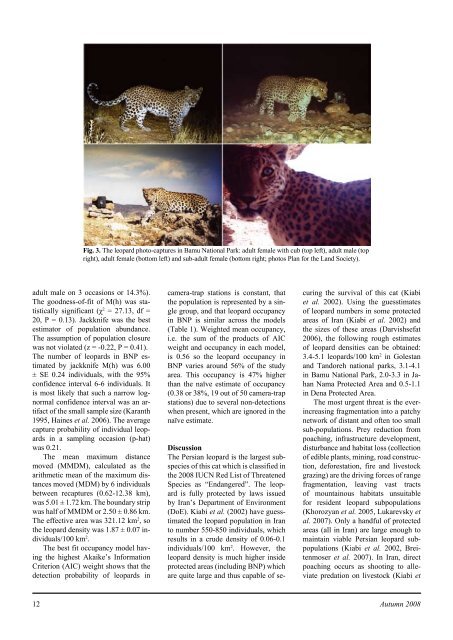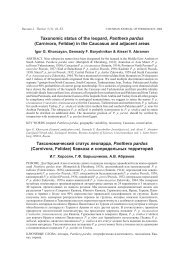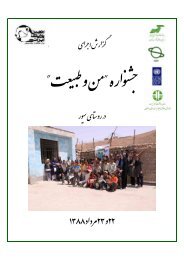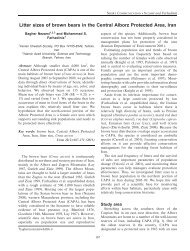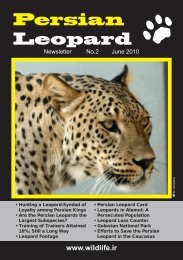The Status of the Persian Leopard in Bamu National Park, Iran
The Status of the Persian Leopard in Bamu National Park, Iran
The Status of the Persian Leopard in Bamu National Park, Iran
You also want an ePaper? Increase the reach of your titles
YUMPU automatically turns print PDFs into web optimized ePapers that Google loves.
Fig. 3. <strong>The</strong> leopard photo-captures <strong>in</strong> <strong>Bamu</strong> <strong>National</strong> <strong>Park</strong>: adult female with cub (top left), adult male (top<br />
right), adult female (bottom left) and sub-adult female (bottom right; photos Plan for <strong>the</strong> Land Society).<br />
adult male on 3 occasions or 14.3%).<br />
<strong>The</strong> goodness-<strong>of</strong>-fit <strong>of</strong> M(h) was statistically<br />
significant (χ 2 = 27.13, df =<br />
20, P = 0.13). Jackknife was <strong>the</strong> best<br />
estimator <strong>of</strong> population abundance.<br />
<strong>The</strong> assumption <strong>of</strong> population closure<br />
was not violated (z = -0.22, P = 0.41).<br />
<strong>The</strong> number <strong>of</strong> leopards <strong>in</strong> BNP estimated<br />
by jackknife M(h) was 6.00<br />
± SE 0.24 <strong>in</strong>dividuals, with <strong>the</strong> 95%<br />
confidence <strong>in</strong>terval 6-6 <strong>in</strong>dividuals. It<br />
is most likely that such a narrow lognormal<br />
confidence <strong>in</strong>terval was an artifact<br />
<strong>of</strong> <strong>the</strong> small sample size (Karanth<br />
1995, Ha<strong>in</strong>es et al. 2006). <strong>The</strong> average<br />
capture probability <strong>of</strong> <strong>in</strong>dividual leopards<br />
<strong>in</strong> a sampl<strong>in</strong>g occasion (p-hat)<br />
was 0.21.<br />
<strong>The</strong> mean maximum distance<br />
moved (MMDM), calculated as <strong>the</strong><br />
arithmetic mean <strong>of</strong> <strong>the</strong> maximum distances<br />
moved (MDM) by 6 <strong>in</strong>dividuals<br />
between recaptures (0.62-12.38 km),<br />
was 5.01 ± 1.72 km. <strong>The</strong> boundary strip<br />
was half <strong>of</strong> MMDM or 2.50 ± 0.86 km.<br />
<strong>The</strong> effective area was 321.12 km 2 , so<br />
<strong>the</strong> leopard density was 1.87 ± 0.07 <strong>in</strong>dividuals/100<br />
km 2 .<br />
<strong>The</strong> best fit occupancy model hav<strong>in</strong>g<br />
<strong>the</strong> highest Akaike’s Information<br />
Criterion (AIC) weight shows that <strong>the</strong><br />
detection probability <strong>of</strong> leopards <strong>in</strong><br />
camera-trap stations is constant, that<br />
<strong>the</strong> population is represented by a s<strong>in</strong>gle<br />
group, and that leopard occupancy<br />
<strong>in</strong> BNP is similar across <strong>the</strong> models<br />
(Table 1). Weighted mean occupancy,<br />
i.e. <strong>the</strong> sum <strong>of</strong> <strong>the</strong> products <strong>of</strong> AIC<br />
weight and occupancy <strong>in</strong> each model,<br />
is 0.56 so <strong>the</strong> leopard occupancy <strong>in</strong><br />
BNP varies around 56% <strong>of</strong> <strong>the</strong> study<br />
area. This occupancy is 47% higher<br />
than <strong>the</strong> naïve estimate <strong>of</strong> occupancy<br />
(0.38 or 38%, 19 out <strong>of</strong> 50 camera-trap<br />
stations) due to several non-detections<br />
when present, which are ignored <strong>in</strong> <strong>the</strong><br />
naïve estimate.<br />
Discussion<br />
<strong>The</strong> <strong>Persian</strong> leopard is <strong>the</strong> largest subspecies<br />
<strong>of</strong> this cat which is classified <strong>in</strong><br />
<strong>the</strong> 2008 IUCN Red List <strong>of</strong> Threatened<br />
Species as “Endangered”. <strong>The</strong> leopard<br />
is fully protected by laws issued<br />
by <strong>Iran</strong>’s Department <strong>of</strong> Environment<br />
(DoE). Kiabi et al. (2002) have guesstimated<br />
<strong>the</strong> leopard population <strong>in</strong> <strong>Iran</strong><br />
to number 550-850 <strong>in</strong>dividuals, which<br />
results <strong>in</strong> a crude density <strong>of</strong> 0.06-0.1<br />
<strong>in</strong>dividuals/100 km 2 . However, <strong>the</strong><br />
leopard density is much higher <strong>in</strong>side<br />
protected areas (<strong>in</strong>clud<strong>in</strong>g BNP) which<br />
are quite large and thus capable <strong>of</strong> secur<strong>in</strong>g<br />
<strong>the</strong> survival <strong>of</strong> this cat (Kiabi<br />
et al. 2002). Us<strong>in</strong>g <strong>the</strong> guesstimates<br />
<strong>of</strong> leopard numbers <strong>in</strong> some protected<br />
areas <strong>of</strong> <strong>Iran</strong> (Kiabi et al. 2002) and<br />
<strong>the</strong> sizes <strong>of</strong> <strong>the</strong>se areas (Darvishsefat<br />
2006), <strong>the</strong> follow<strong>in</strong>g rough estimates<br />
<strong>of</strong> leopard densities can be obta<strong>in</strong>ed:<br />
3.4-5.1 leopards/100 km 2 <strong>in</strong> Golestan<br />
and Tandoreh national parks, 3.1-4.1<br />
<strong>in</strong> <strong>Bamu</strong> <strong>National</strong> <strong>Park</strong>, 2.0-3.3 <strong>in</strong> Jahan<br />
Nama Protected Area and 0.5-1.1<br />
<strong>in</strong> Dena Protected Area.<br />
<strong>The</strong> most urgent threat is <strong>the</strong> ever<strong>in</strong>creas<strong>in</strong>g<br />
fragmentation <strong>in</strong>to a patchy<br />
network <strong>of</strong> distant and <strong>of</strong>ten too small<br />
sub-populations. Prey reduction from<br />
poach<strong>in</strong>g, <strong>in</strong>frastructure development,<br />
disturbance and habitat loss (collection<br />
<strong>of</strong> edible plants, m<strong>in</strong><strong>in</strong>g, road construction,<br />
deforestation, fire and livestock<br />
graz<strong>in</strong>g) are <strong>the</strong> driv<strong>in</strong>g forces <strong>of</strong> range<br />
fragmentation, leav<strong>in</strong>g vast tracts<br />
<strong>of</strong> mounta<strong>in</strong>ous habitats unsuitable<br />
for resident leopard subpopulations<br />
(Khorozyan et al. 2005, Lukarevsky et<br />
al. 2007). Only a handful <strong>of</strong> protected<br />
areas (all <strong>in</strong> <strong>Iran</strong>) are large enough to<br />
ma<strong>in</strong>ta<strong>in</strong> viable <strong>Persian</strong> leopard subpopulations<br />
(Kiabi et al. 2002, Breitenmoser<br />
et al. 2007). In <strong>Iran</strong>, direct<br />
poach<strong>in</strong>g occurs as shoot<strong>in</strong>g to alleviate<br />
predation on livestock (Kiabi et<br />
12 Autumn 2008


